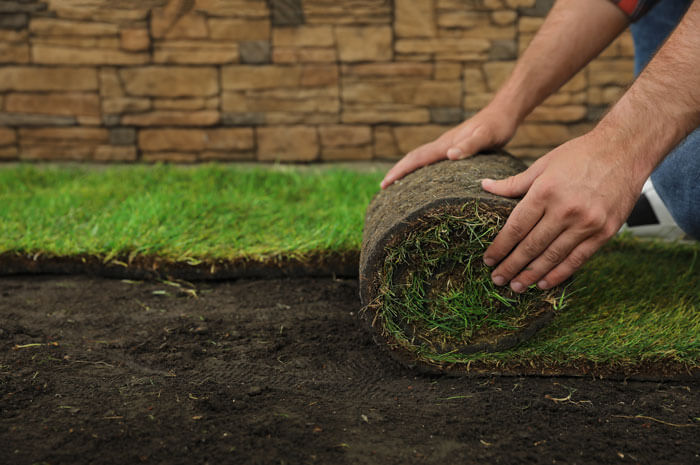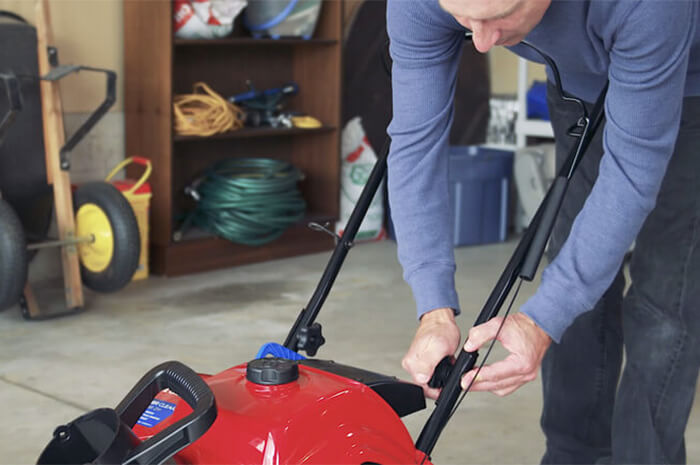
There are four ways to plant grass: sod, seed, sprigs, and plugs. A common point of conflict is this question: “What’s the best way to plant grass?”.
The answer is simple. The best way to plant grass depends on your budget and your project requirements. No matter your method of choice, in this article, you’ll learn how to implement each method in order to encourage a healthy lawn.
How to Plant a Lawn Using Sod
Before your sod arrives, remove the grass on your lawn. This is very important. Sod planted on top of grass typically dies over a period of weeks, leaving a rotten, slimy mess underneath.
Once you’re done removing your grass, apply a starter fertilizer high in phosphorus, such as 2:1:1 or 1:1:1 ratio, then lightly water the area. Have the pallets of sod delivered to a shady spot if possible and begin work immediately upon delivery of your order. Sod can go bad quickly, especially if it heats up or dries out. If you cannot start right away, unroll the sod and keep it moist.
Preparing Your Soil For Sod
- Immediately upon delivery, check sod for damage, such as a yellow-green or bluish color, weeds, tears, disease, and insects. Reject bad sod.
- Prepare soil for sod by raking it to even it out. After that, remove any stones and vegetative matter that’s surfaced.
- Even your soil with a roller that is one-third full of water. You’ll be able to rent a roller at many hardware stores.
- You will fill most rollers from the side of the drum. Remove the rubber stopper, fill with water, and replace the stopper. You are ready to roll.
- The rolled soil should be compacted enough so your footprints are no more than ½-inch deep.
- Lightly water the area and walk on it as little as possible.
- Use a sharp knife to cut sod. Some pros sharpen the edge of a trowel to cut sod.
Laying Down Sod
Lay sod over one section of lawn at a time. Start by laying full strips along the outside edge (such as the sidewalk) of the area you plan to sod. Starting with a straight row will reduce the amount of cutting and fitting you will do later. Work toward the opposite edge of the lawn, usually the edge by your house. Use a sharp-bladed knife or sod-cutting tool to cut as required. Make your last row a full-width strip, if possible.
- Sharpened trowels are used by professionals as trowels make it easy to cut sod to fit at butt joints or when cutting against a straightedge.
- You may also use a trowel to level any minor irregularities in the soil while laying sod.
- As you lay sod, keep all joints as snug as possible while avoiding overlapping. Do not stretch sod strips to fill gaps. To fit sod at odd angles, lay one piece over the other and cut through both at once. Lift the top piece, remove the piece below and discard.
- After you have installed several pieces of sod, spray with water until the sod is completely soaked—about 1 inch of water.
- To fit sod at odd angles, lay one piece over the other and cut through both at once. Lift the top piece, remove the piece below and discard.
- Using a long board as a straightedge, make your cut and discard the waste.
- It is important to have full strips at the perimeter. These are the strips most likely to dry out and will do so more quickly if narrow or short.
- Use a sharp edger to trim bed where necessary, and use a roller to eliminate air pockets under the sod.
- If rolling exposes joints between the sod strips, fill them with fine soil. Use a rake to work the soil into small cracks.
Below are a few more important tips for planting a lawn with sod:
With contoured borders such as paths, driveways, and patios, overlap the border with sod, and trim away the excess (can be done later). If you have sod you will not be able to lay until the next day, unroll it in a shady spot and water it lightly.
If you decide to sod your lawn in sections, you will need to lay sod against part of the existing lawn. Use cutoffs longer than 2 feet to begin new rows and short lengths of sod in the interior. Mark the dividing line with twine or stakes. Use the twine or stakes as a guide and cut a straight line in the existing turf using a manual or power edger. Lay sod to this edge, and make a tight, unobtrusive seam. When laying out the sod, kneel to the sodded side of each row, using a sheet of plywood under your knees to avoid damaging the grass.
If you are installing sod on a slope, start laying the sod at the lowest point. Stake each piece in three places to prevent slippage. Stakes should be equally spaced and set in from the sod strip’s edges by at least 6 to 8 inches. In hot weather, lightly watering the sod prior to rolling will also help prevent slippage.
After installing the sod, make it firm by rolling it with a roller that is one-third full with water. If the roller is too heavy, it could cause the sod to slip. Immediately after rolling, give the sod a thorough soaking—to a soil depth of 6 to 8 inches—and restrict traffic for several weeks.
How to Plant a Lawn with Seed
Apply a starter fertilizer (one with a nutrient ratio of 1:1:1 or 1:2:1) to the prepared surface, but do not till it in. Spread the best seed you can afford at the rate recommended by the seed packager. The rates are generally in pounds per 1,000 square feet.
Don’t have access to specific recommendations from the seed packager? The rule of thumb for seed coverage is 15 to 20 seeds per square inch, use less when conditions are favorable or more when they are not.
Make trial passes with your spreader, and adjust it until you achieve seven or eight seeds per square inch. Spread seed in two passes, first in one direction and then in a perpendicular direction, to ensure even coverage of about 15 seeds per square inch. If your spreader delivers too much seed even when set on the lowest setting then you should bulk up the seed using vermiculite or sand.
Rake the seeded surface lightly to mix the seed with the top 1/8-inch of soil, and then roll using an empty roller to improve the germination rate.
Best Method for Planting Grass Seed on a Slope
Seeding sloped areas is difficult because the seed tends to run to low points when it rains. One solution is to contract with a landscaper who has hydroseeding equipment. Hydroseeding involves spraying a suspension of fertilizer, mulch, and water onto the prepared surface. Apply frequent light waterings to hydroseeded surfaces to keep them from drying out.
How to Plant a Lawn Using Sprigs
Sprigs and plugs are similar in that they’re a sample of grass. A sprig is only a piece of grass stem while a plug is a small square or circle of sod. There are two ways of planting sprigs. You can broadcast, also called stolonize your sprigs or you can plant sprigs in furrows. No matter how you choose to plant, you’ll want to bury sprigs so that the top quarter of each plant is exposed. Space them 6- to 12-inches apart, depending on the grass type.
Planting Grass Sprigs: Broadcast or Stolonize Method
You can broadcast, or stolonize, sprigs over prepared soil at a rate of 5- to 10-bushels per 1,000-square feet. Then cover with 1/4 to 1/2 an inch of soil, and press the sprigs into the soil by rolling.
Planting Grass Sprigs: Furrow Method
You can plant the sprigs in shallow furrows, 1 to 2 inches deep and 6 to 12 inches apart, depending on the grass variety and the sprig producer’s spacing recommendations. Plant end-to-end in 4 to 6-inch intervals, and cover with soil. Be sure a portion of each sprig remains exposed to light, ideally one-quarter of its length, and then lightly roll or tamp the planted area to press the sprigs into the soil.
Planting a Lawn Using Plugs
Plugs should be planted 6- to 12-inches apart depending on grass type and grower recommendations. Plant plugs in furrows or holes every 6 to 12 inches in each direction depending on grass type. For slower-spreading grasses, such as Zoysiagrass, plant 6 inches apart. You can plant grasses that spread more quickly, such as St. Augustinegrass or Bermudagrass, farther apart.
You can purchase plugs or make your own from unwanted areas of turf. If you are digging individual holes, using a bulb planter will make the job quicker. Use a golf-green cup cutter to cut circular plugs, or use a sharp knife, such as a machete, to cut 2-inch-square plugs.
Beyond Planting Grass: Discover More Toro YardCare
Now that you’ve read about the many ways to plant grass, we hope you’re confident as you move on to your lawn project. An expert in all things lawncare and gardening, we encourage you to explore our blogs once you’re done planting your lawn. Whether you need help mowing or taking down weeds, we’ll help you every step of the way.



